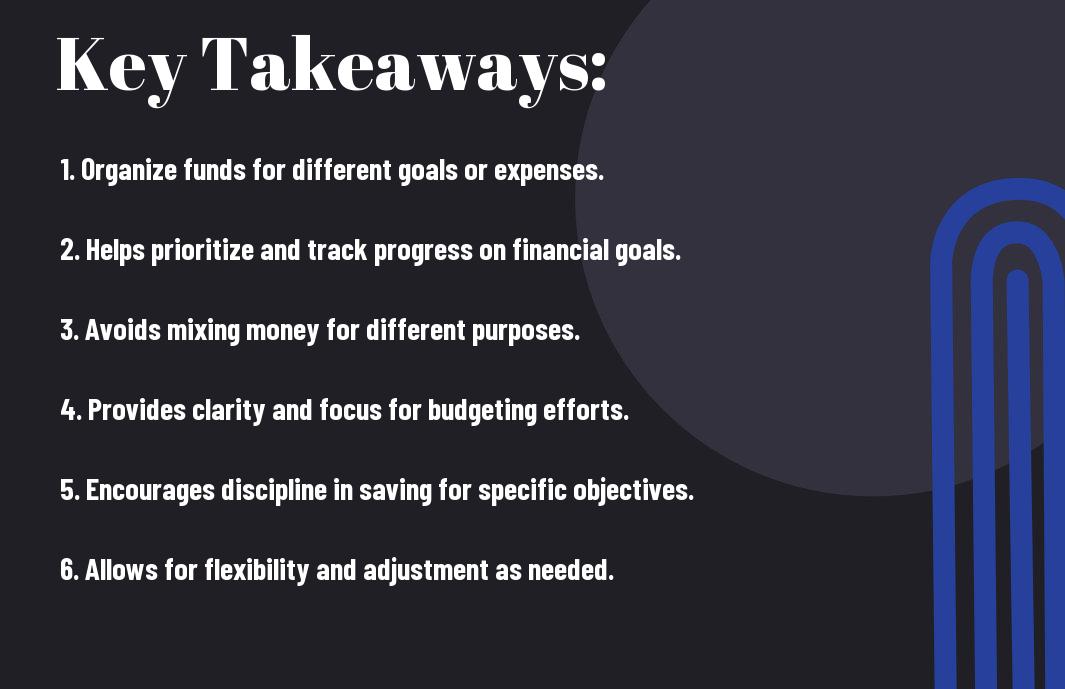With careful planning and strategic allocation of funds, creating savings “buckets” can be a highly effective method to reach your financial goals and manage expenses. This approach involves compartmentalizing your savings into specific categories or goals, allowing you to easily track your progress and stay motivated to stick to your budget. By assigning each bucket a purpose, such as an emergency fund, vacation fund, or home renovation fund, you can prioritize your savings and make sure your money is working for you in the best way possible.
What Are Savings Buckets?
Definition and Basic Concept
Before stepping into the details of savings buckets, it’s important to understand the concept behind them. Savings buckets are a strategic way of allocating funds within your budget for specific goals or expenses. By creating separate “buckets” for different financial objectives, such as emergency savings, vacation fund, or home renovations, you can easily track your progress and ensure that your money is being used efficiently.
The Benefits of Using Savings Buckets in Budgeting
Any individual or household looking to take control of their finances can benefit from using savings buckets in budgeting. By dividing your savings into specific categories, you can prioritize your financial goals and avoid the temptation of dipping into funds meant for other purposes. According to a recent survey, individuals who use savings buckets are 25% more likely to achieve their financial goals compared to those who do not utilize this budgeting strategy.
Creating Your Savings Buckets
Identifying Financial Goals and Priorities
If you want to take control of your finances and reach your goals, you need to start by identifying your financial goals and priorities. This could include saving for an emergency fund, a vacation, a down payment on a house, or even retirement. By setting clear goals, you can determine how much money you need to save and create specific buckets within your budget to allocate funds for each goal.
How to Set Up Different Buckets for Various Needs
With the concept of savings buckets, you can allocate funds for specific goals or expenses. For example, if your goal is to save for a vacation, you can create a separate bucket for it within your budget. By setting aside a certain amount of money each month for this specific goal, you can track your progress and stay on track to reach your savings target. This approach can help you prioritize your spending and make sure that you are allocating enough money towards your financial goals.
A study conducted by a financial institution found that individuals who set specific savings goals are more likely to achieve them compared to those who do not have a clear plan in place. By creating savings buckets for different financial goals, you can stay focused, motivated, and ultimately reach your objectives.
Strategies for Allocating Funds
Percentage-Based Allocation
Not sure how to start allocating funds for your savings buckets within your budget? Consider a percentage-based approach recommended by experts. According to Capital One, the 50-20-30 budgeting rule is a popular method that suggests allocating 50% of your income to needs, 20% to savings, and 30% to wants.
Fixed Amount Contributions
With fixed amount contributions, you set aside a specific dollar amount towards each savings bucket. This approach allows you to allocate funds consistently and helps prioritize your financial goals. For instance, you can designate $200 per month towards an emergency fund, $100 towards a vacation fund, and $50 towards a new car fund.
Types of Savings Buckets
- Emergency Fund Bucket
- Vacation and Travel Bucket
- Retirement Savings Bucket
- Education Savings Bucket
- Big-Purchase Savings Bucket
Emergency Fund Bucket
An emergency fund is a crucial savings bucket that should be a top priority for every budget. This fund acts as a financial safety net in case of unexpected expenses, such as medical emergencies, car repairs, or job loss. Financial experts recommend saving at least 3 to 6 months’ worth of expenses in your emergency fund to provide a solid cushion in times of need.
Though it may take time to build up, an emergency fund offers peace of mind and financial security for any unforeseen circumstances that may arise.
Vacation and Travel Bucket
On the lighter side of savings buckets, the vacation and travel bucket is a fun way to allocate funds for leisure activities and getaways. Setting aside a portion of your budget specifically for travel allows you to plan and budget for vacations without dipping into your regular savings. Whether it’s a weekend getaway or a dream vacation abroad, having a designated travel fund ensures you can satisfy your wanderlust without impacting your other financial goals.
Funding your vacation and travel bucket regularly not only allows you to indulge in experiences that bring joy and relaxation but also helps you avoid going into debt for your leisure activities.
Retirement Savings Bucket
Savings for retirement is a long-term goal that requires consistent dedication and planning. Setting up a retirement savings bucket is imperative to ensure a comfortable and financially secure future. It is recommended to save a certain percentage of your income each month towards retirement, taking advantage of employer-sponsored retirement accounts and other investment options to grow your savings over time.
Saving for retirement early on can significantly impact the quality of life you lead in your golden years, so it’s crucial to prioritize this savings bucket in your budget.
Education Savings Bucket
Traveling down the road of higher education can come with significant financial implications. An education savings bucket allows you to save for your or your children’s education expenses, whether it’s for college tuition, trade school, or continuing education courses. By allocating funds specifically for educational purposes, you can prepare for these costs without borrowing heavily in student loans or derailing your other financial goals.
Saving in an education bucket not only helps cover the costs of educational pursuits but also provides greater financial flexibility and reduces the burden of debt in the long run.
Big-Purchase Savings Bucket
One-time big purchases, such as a new car, home upgrades, or large appliances, can strain your budget if not planned for in advance. By creating a big-purchase savings bucket, you can save up for these expenses over time and avoid putting a significant dent in your finances or resorting to high-interest loans. This bucket allows you to set aside money gradually, ensuring that when the time comes to make the purchase, you have the necessary funds readily available.
Vacationing in a responsible budget will create financial security in the long run and help you achieve your financial goals without unnecessary stress.

Managing and Adjusting Your Buckets
Tracking Your Contributions and Growth
Now that you have set up your savings buckets within your budget, it is crucial to track your contributions and monitor the growth of each bucket over time. By regularly reviewing your progress towards your savings goals, you can ensure that you stay on track and make any necessary adjustments to your budget.
Adjusting Allocations as Goals or Circumstances Change
Allocating funds to specific savings buckets is a dynamic process that may require adjustments as your financial goals or circumstances change. For example, if you receive a salary increase, you may choose to allocate a portion of that extra income towards a specific savings goal to expedite your progress.
Change is a constant in life, and your budget should reflect that. By regularly evaluating and adjusting your allocations based on your evolving goals and circumstances, you can ensure that your savings buckets remain aligned with your financial priorities.

Common Challenges and Solutions
Staying Disciplined with Contribution
To effectively manage savings buckets within your budget, it is necessary to stay disciplined with your contribution towards each bucket. Allowing for fluctuating contributions or skipping contributions altogether can hinder the progress towards your financial goals. To maintain consistency, set up automated transfers or reminders to ensure that funds are allocated to each bucket regularly.
Handling Unexpected Expenses and Setbacks
On the journey towards achieving your financial goals, unexpected expenses or setbacks can often arise, derailing your progress. It is crucial to have a contingency plan in place to handle these unforeseen circumstances without affecting your savings buckets. For instance, consider building an emergency fund to cover any unexpected expenses that may arise, allowing you to stay on track with your budgeting goals.

Integrating Savings Buckets with Other Financial Tools
Your budgeting system can be enhanced by integrating savings buckets with other financial tools. By creating specific buckets for various goals or expenses, you can track your progress more effectively and stay motivated to reach your financial objectives. A recent article on LinkedIn titled Buckets of Benefits: Why You Need a Budgeting System for Kids highlights the importance of using buckets in budgeting to instill financial discipline in children from a young age, further emphasizing the value and versatility of this approach.
Automating Contributions for Efficiency
To streamline your savings process, consider automating contributions to your different buckets. Set up automatic transfers from your checking account to each bucket on a regular basis. This not only ensures that you are consistently saving towards your financial goals but also makes the process more convenient and efficient. By automating contributions, you can remove the temptation to spend the money earmarked for your savings buckets on other expenses, helping you stay on track towards achieving your desired outcomes.
Using Apps and Software to Manage Your Buckets
Any modern-day budgeting system can benefit from incorporating apps and software tools to manage your savings buckets. There are numerous financial management apps available that allow you to create customized buckets for different purposes, track your progress, set savings goals, and receive alerts or reminders to stay on top of your financial plan. These tools can provide valuable insights into your spending habits, help you identify areas for improvement, and ultimately empower you to make more informed financial decisions. By leveraging technology to manage your savings buckets, you can optimize your budgeting process and increase your chances of achieving your financial goals.
Other financial tools such as online banking platforms, budgeting software, and investment apps can also complement your savings buckets strategy by offering additional features such as goal tracking, expense categorization, and investment opportunities. By integrating these tools with your savings buckets, you can create a comprehensive financial ecosystem that supports your overall financial wellbeing and empowers you to make smarter financial choices.

Conclusion
Hence, utilizing the concept of creating savings “buckets” within your budget can be a powerful and creative approach to achieving financial goals. By allocating funds specifically for certain goals or expenses, you are able to visually see your progress and stay motivated to reach your targets. This method of budgeting not only helps you prioritize your spending but also allows you to feel more in control of your finances.
Whether you are saving for a vacation, a new car, or an emergency fund, dividing your savings into buckets can help you stay on track and prevent any impulse spending on non-crucial items. This strategy also allows for flexibility, as you can adjust the amount you allocate to each bucket based on changing priorities or financial circumstances. Overall, creating savings “buckets” can be an effective tool to help you stay organized, motivated, and successful in reaching your financial goals.
FAQ
Q: What are savings buckets in the context of budgeting?
A: Savings buckets are designated categories within your budget where you allocate funds for specific goals or expenses. This helps you organize and prioritize your savings towards different purposes.
Q: How can creating savings buckets help in managing finances effectively?
A: By creating savings buckets, you can clearly define your financial goals and allocate funds accordingly. This ensures that you are actively saving towards specific objectives, preventing funds from being scattered or overspent.
Q: What are some common types of savings buckets that one can create?
A: Common types of savings buckets include emergency fund, vacation fund, home improvement fund, retirement fund, and education fund. These buckets help you save towards specific short-term or long-term financial goals.



